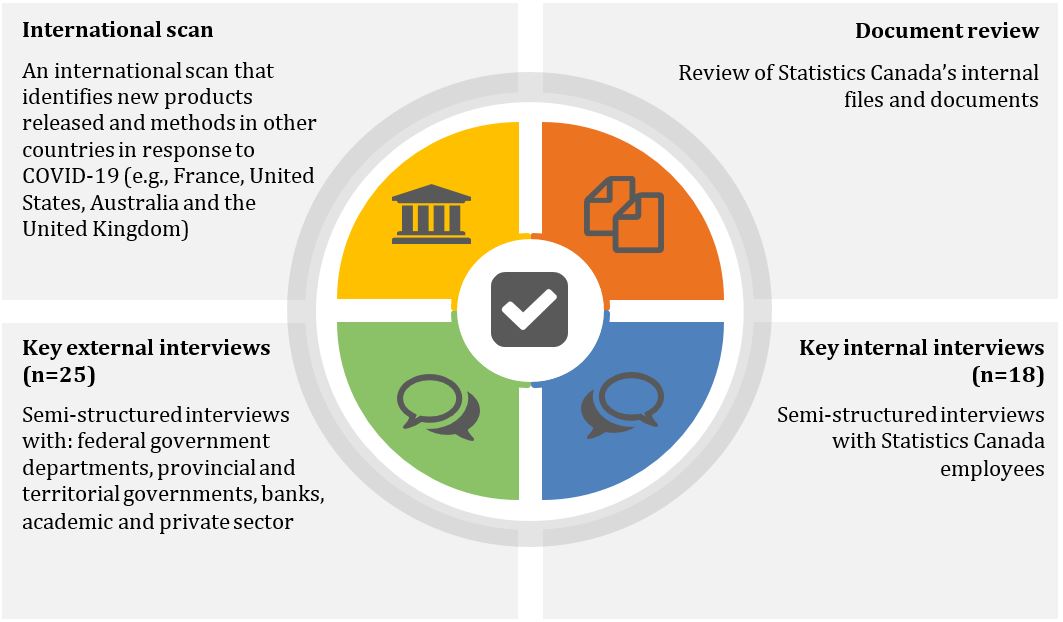Canadian Statistics Advisory Council 2021 Annual Report - Strengthening the foundation of our National Statistical System
Release date: December 16, 2021
Message from the Canadian Statistics Advisory Council
The Canadian Statistics Advisory Council (CSAC) was created to enhance the independence of Statistics Canada, Canada's national statistical organization, and to offer advice to the Minister of Innovation, Science and Industry and the Chief Statistician of Canada. As part of its mandate, CSAC is tasked with producing an annual report on the state of Canada's statistical system. Our mission is to provide impartial and independent advice to ensure the quality, relevance and accessibility of the national statistical system.
In 2020, CSAC released its first report in a context that was shaped by the COVID-19 pandemic and increased mobilization against racial injustice. We focused on the need for high-quality statistical information to address nationwide health issues and socio-economic inequities. We also engaged the need to collect these data while respecting the privacy of Canadians' personal information.
To meet the expectations and needs of Canadians and to ensure a robust national statistics system, we focus in this report on the characteristics of an effective and representative system. We stress the need to update policies and legislation that govern the national statistical system and the need to clarify and strengthen Statistics Canada's role as data steward. We identify opportunities, barriers and critical data needs that need to be pursued, overcome and addressed.
The Council is grateful to Statistics Canada, Anil Arora, the Chief Statistician of Canada, who is an ex-officio member of the Council, and his excellent team for responding to our requests for information with both written and oral presentations to our working groups and meetings. We would like to offer our very particular thanks to Melanie Forsberg, Kacie Ha, and Sam Ndayishimye of the CSAC Secretariat for their advice and assistance.
We trust that our report and advice be accepted by the Minister on behalf of the Government of Canada and will strengthen Canada's national statistical system to help the government and Canadians build a vibrant economy and a healthy population, as well as address the pressing problems the country faces today and in the years to come.
Signed: The Canadian Statistics Advisory Council
Annette Hester
Dr. Céline Le Bourdais
David Chaundy
Gail Mc Donald
Gurmeet Ahluwalia
Dr. Howard Ramos
Jan Kestle
Dr. Michael C. Wolfson
Executive summary
Information and data are among Canada's most valuable resources Both affect every aspect of Canadians' lives, from connecting with family and friends, to running businesses, to responding to pressing problems. They are foundations of a modern economy fuelled by people, diversity, an innovative drive, and a robust national statistical system that crosses all sectors and communities.
Leading edge Canadian public and private sector organizations are driving the use of digital information to better understand the issues Canadians face. There is also a wealth of public and private data in this country that is not part of the national statistical system. When built upon common concepts and definitions, as well as shared standards, these data can bring new perspectives to help inform some of the more complex issues Canadians face.
The federal government must be a leader and support the creation of national data as a tool to meet the expectations and needs of today and to be ready for those of tomorrow. Canada faces urgent data needs in a number of areas, such as health, diversity and environment. The creation of national data is hampered by government departments at all levels of jurisdiction that tend to be siloed, which makes sharing and integrating data among departments and across jurisdictions difficult, if not impossible. The underlying legal, policy and cost barriers are complex and challenging. However, it is time for outdated government infrastructures to be modernized and coordinated to meet the expectations of Canadians and tackle the 21st century problems they face.
For Canada to succeed in an increasingly dynamic digital world, Statistics Canada's role is key. The agency is an independent and trusted source of official statistics and provides a solid foundation for government accountability and evidence-based decision making by both the public and the private sectors, which benefits all Canadians. Statistics Canada's role as data steward in the country's statistical systems needs to be clarified and strengthened in the Statistics Act. The Act is ambiguous regarding what role Statistics Canada has in assuring common data standards and coordination of data, in some cases leading to confusion in the Act's interpretation and implementation.
Recent events such as the COVID-19 pandemic and the Black Lives Matter and Indigenous Lives Matter movements have heightened a growing recognition among Canadians and decision makers of how important reliable detailed information is to understand many of the issues facing Canadians. There is an urgent need for nimble, flexible data systems, as pressing problems and critical events are often unexpected. In general, the pace of change today occurs much more quickly than the change captured in quinquennial census information or data collected from annual surveys. There are new untapped sources of information that can provide more realtime data and accurate portraits of Canadians and their communities.
Data sources on their own generally do not provide the breadth, depth or interconnections required to examine more complex issues such as socioeconomic inequalities and environmental impacts from and on businesses. For analysis, datasets need to be constructed from multiple sources by linking and connecting relevant variables under clearly specified confidentiality and security protocols. Such data environments can be successful only if done within Canada's broader data system, which includes all levels of government, First Nations, Inuit and Métis organizations and communities, and non-government entities. New and mutually beneficial partnerships are required to facilitate connecting data from different institutions in adherence to national standards on definitions, concepts and coding.
Recommendation 1.
Adapting governance and data stewardship to a digital society
Canada is an increasingly digital country, with information and data among its most valuable resources. Working within the national statistical system, Statistics Canada is often constrained in its ability to deliver what Canadians expect and need to create prosperity and well-being in a world marked by a digital future. Even with digital modernization efforts, the statistical system is hampered by fragmentation, unused data and unmet data needs in critical sectors. These are largely a consequence of the inherited historical governance structure between Statistics Canada and federal departments, provinces and territories. New governance models are needed that bring broader perspectives and partnerships.
First Nations, Inuit and Métis communities are each developing a distinctions-based approach to asserting their unique jurisdiction, ownership and control over their data that relates to their identity, their people, language, history, culture and communities. Information, data and capacity development investments are important at the community, regional and national levels to support these efforts. Partnerships with Statistics Canada should be pursued without prejudice or harm to existing and future processes.
It is recommended that the Minister of Innovation, Science and Industry and the Chief Statistician
- 1.1 Take leadership in supporting a national data system that
- delivers collaborative frameworks that include clearly defined roles and accountabilities for Statistics Canada and partners from public, Indigenous, private and other sectors
- establishes Statistics Canada's role as the national data steward, based on a whole of government approach to defining and prioritizing data needs as an integral part of federal program planning
- applies legislation and policies to support and incentivize active administration of national data standards and real-time nationwide data flows involving all government jurisdictions.
- 1.2 Through clearly defined and distinctions-based governance partnerships with Indigenous organizations and communities, support the advancement of First Nations, Inuit and Métis led governance capacities, data priorities and active participation in and contribution to the national data system.
Recommendation 2.
Statistical legislation must reflect the needs of a modern digital national statistical system
Data derived from a modern digital society are essential to informed decision making for pandemic recovery initiatives, for reconciliation and a renewed relationship with Indigenous peoples, for tackling the climate crisis, and for addressing key issues the country will face for decades to come Strong, clear and unambiguous statistical legislation is important to support the national data system, including its national data strategies.
Modern digital technology for collecting, transferring and sharing statistical information is not well reflected in the Statistics Act, which affects how the statistical legislation is interpreted. Much of the language pertaining to the collection and storing of statistical information is essentially unchanged since 1918.
It is recommended that the Minister of Innovation, Science and Industry and the Chief Statistician
- 2.1 update the Statistics Act to reflect a modern digital society
- 2.2 clarify and strengthen in the Statistics Act Statistics Canada's data stewardship role
- 2.3 introduce a new category of accredited users from government, academic and private research institutions, and Indigenous organizations and communities who would be granted access to more disaggregated microdata without having to be deemed employees of Statistics Canada.
- 2.4 update the Statistics Act to support participation of Statistics Canada and federal departments in reconciliation efforts and a renewed relationship with First Nations, Inuit, and Métis with respect to coordination and governance of data and information to support planning, building capacity and decision making by all stakeholders to address critical data needs.
Recommendation 3.
Leveraging opportunities for addressing critical data needs
Critical data gaps and a lack of coordinated data in Canada seriously undermine the ability of public and private decision makers and the general public to understand and address key social, economic, and environmental issues facing Canadians. In many cases, these serious data gaps stem from complex and longstanding issues involving multiple jurisdictions, competing interests and inadequate national direction and authority. Understanding and acting upon these impediments is essential to allow development of national and nationwide data that can be used to inform pressing issues of today and of tomorrow.
It is recommended that the Minister of Innovation, Science and Industry and the Chief Statistician
- 3.1 develop and communicate principles for working with multidisciplinary connected datasets as an important component of national data strategies
- 3.2 broaden and deepen reciprocal relationships with federal departments and agencies, other levels of government, Indigenous jurisdictions and the private sector to enable sharing of data to build truly national and nationwide data infrastructures.
- invest in and provide incentives for the effective implementation of advanced real-time software and communications technologies to enable data sharing and connecting of data across jurisdictions and organizations.
- invest in innovative data collection and measures that move beyond econocentric environment models to include elements of quality of life and sustainability.
Introduction
Information and data are among Canada's most valuable resources Both affect every aspect of Canadians' lives, from connecting with family and friends, to running businesses, to responding to pressing problems. They are foundations of a modern economy fuelled by people, diversity, an innovative drive and a robust national statistical system that crosses all sectors and communities.
Events such as the global COVID-19 pandemic, racial injustice, the tragedy of Indigenous residential schools and the climate crisis cannot adequately be addressed without high quality data and a coordinated statistical system. Such a system is also key to offering Canadians a more prosperous and robust quality of life.
Collection and coordination of data from Canadians, from government departments and from Canadian businesses should be a public good. It is an essential infrastructure to support a strong economy and well-functioning society. In a modern and increasingly complex society, new and innovative sources of data and methods are required to effectively capture how Canadians are faring. It is key to sound decision making.
For Canada to succeed in an increasingly dynamic digital world, Statistics Canada's role is key. Canadians look to Statistics Canada for high quality information. Footnote 1
The agency is an independent and trusted source of official statistics and provides a solid foundation for government accountability and evidence-based decision making by both the public and the private sectors, which benefits all Canadians. It is also an agency that prizes confidentiality of people's information and weighs the necessity of collecting this information in all the work it does.
Statistics Canada, however, cannot alone support all of Canada's data needs. To meet its mandate and to be an effective agency, it must work with public and private sector partners to produce quality comparable data that are representative of all Canadians. This can be done only with national data standards so that important data produced by all sectors are comparable and can be shared across jurisdictions, not only routinely, but also when required to meet unexpected and critical data needs.
A strong statistical system must also be driven by inclusive strategic thinking on how social, economic and environmental factors contribute to issues and what data are needed to better understand and address them. This means collaborative frameworks that include Statistics Canada and partners from different sectors, with their roles and accountabilities clearly defined. It also means that individual Canadians need to do their part in sharing their data in exchange for high-quality statistics, statistical information and effective service delivery.
The federal government must be a leader and support the creation of national data as a tool to meet the expectations and needs of today and to be ready for those of tomorrow. Canada faces urgent data needs in a number of areas such as health and environment. There is also a lack of sufficient data to speak to the detailed and lived experiences of racialized Canadians, Indigenous communities, and all citizens in their various demographic intersections from coast-to-coast-to-coast. This is hampered by government departments at all levels of jurisdiction that tend to be siloed, rendering sharing and integration of data among them and across jurisdictions difficult, if not impossible. The underlying legal, policy and cost barriers are complex and challenging. However, it is time for outdated government infrastructures to be modernized and coordinated to meet the expectations of Canadians and tackle the 21st century problems they face.
This year's report of the Canadian Statistics Advisory Council (CSAC) focuses on principles for development of a national data system to address critical data needs, including new partnerships and capacities for making greater use of Canada's wealth of existing and potential data resources. The Council believes this is essential to build the infrastructure needed for a vibrant economy and a healthy population, and to meet the pressing problems the country faces today and in the years to come.
Recent developments
The Council recognizes the many developments by Statistics Canada and the federal government over the last year that are consistent with recommendations made in its 2020 report.
Increasingly, there is greater recognition of the role of national and nationwide data to support informed decision-making. The importance of official data can be seen in the January 2021 supplemental mandate letters to federal ministers Footnote 2with numerous references to statistics, and in 2021 Federal Budget with important investment announcements for developing data to meet critical data gaps. This includes the creation of a Disaggregated Data Action Plan, a new Census of Environment, and support for the development of data in a number of areas such as longterm and supportive care, quality of life, and clean growth and technology. The need for such investments was discussed in our report last year and is welcome news.
Events over the last year have provided Statistics Canada with opportunities for new strategic partnerships across all levels of government to accelerate innovative initiatives on alternative methods and data sources. In response to many demands for new data to support Canadians and government in their efforts to manage the effects of the pandemic, Statistics Canada has expanded the scope of its operations to leverage innovative statistical methods and tools. These have been applied to central programs such as the Labour Force Survey, and for collecting information through web panels and crowdsourcing. This has enabled reporting for key vulnerable populations, including immigrants and visible minority groups. Web portals, such as the Canadian Statistical Geospatial Explorer and COVID-19: A data perspective, provide data, indicators and analyses on the social and economic impacts of the pandemic on Canadians and their businesses.
The agency is playing key roles as coordinator and collaborator in support of efforts to connect information on the COVID-19 pandemic and assess its impacts on Canadians as it unfolds. This includes supporting the Public Health Agency of Canada (PHAC) on the development of tools, data products and analysis for tracking vaccines supply; forecasting ventilator capacity; refining variables in epidemiological models; and developing social impacts analyses. Leveraging the expertise of its survey interviewers, the agency also supported Health Canada to make the equivalent of over one million calls for contact tracing at the federal and provincial levels. The agency used its expertise in data science and data management to help Health Canada and PHAC work closely with the provinces and territories to better manage the supply and demand of personal protective equipment. Statistics Canada provided expert contributions to the federal economic response to the pandemic, as federal organizations, the Bank of Canada, Crown corporations and regulators were mobilized to strengthen the capacity for economic analysis and advice in support of decision making. The agency also introduced the new Canadian Survey on Business Conditions reports, in partnership with the Canadian Chamber of Commerce and business owners, for current data to understand the expectations of businesses in Canada.
"Statistics Canada is playing key roles as coordinator and collaborator in support of efforts to connect information on the COVID-19 pandemic and assess its impacts on Canadians as it unfolds."
Our report last year supported Statistics Canada's development of its Necessity and Proportionality Framework and recognized the important need to identify the value proposition of all statistical efforts. The concept of necessity relates to the need for Statistics Canada to collect data to produce official statistics that accurately and adequately measure Canadian social, economic and environmental well-being. Proportionality is balancing this need with the need to reduce the response burden on Canadians and to protect the privacy of their information. The agency has now implemented this framework across all programs and is embedding it as a key element within planning and processes.
Statistics Canada, like all departments and partners, had to transform operations to allow its employees to work remotely. This provided an opportunity to accelerate implementing advanced technologies around transmission of and access to confidential data. The 2021 Census was conducted virtually, with the 32,000 enumerators hired for the census conducting much of their work from home, and a large majority of Canadians completing the census questionnaire online. These technologies are also being piloted with the Virtual Data Lab project to broaden remote microdata access to authorized researchers. As this access is rolled out in phases; governance, data stewardship, partnerships and timeliness will be key.
The agency is developing a collaborative data analytics platform that cross- references data from reliable Statistics Canada sources, offering researchers innovative analytics, presentation and dissemination options. These are major developments that will transform how research is conducted in Canada.
1. National statistical system
Recommendation 1.
Adapting governance and data stewardship to a digital society
Canada is an increasingly digital country, with information and data among its most valuable resources.
Working within the national statistical system, Statistics Canada is often constrained in its ability to deliver what Canadians expect and need to create prosperity and well-being in a world marked by a digital future. Even with digital modernization efforts, the statistical system is hampered by fragmentation, unused data and unmet data needs in critical sectors. These are largely a consequence of the inherited historical governance structure between Statistics Canada and federal departments, provinces and territories. New governance models are needed that bring broader perspectives and partnerships.
First Nations, Inuit and Métis communities are each developing a distinctions-based approach to asserting their unique jurisdiction, ownership and control over their data that relates to their identity, their people, language, history, culture and communities. Information, data and capacity development investments are important at the community, regional and national levels to support these efforts. Partnerships with Statistics Canada should be pursued without prejudice or harm to existing and future processes.
It is recommended that the Minister of Innovation, Science and Industry and the Chief Statistician
- 1.1 Take leadership in supporting a national data system that
- delivers collaborative frameworks that include clearly defined roles and accountabilities for Statistics Canada and partners from public, Indigenous, private and other sectors
- establishes Statistics Canada's role as the national data steward, based on a whole-of-government approach to defining and prioritizing data needs as an integral part of federal program planning
- applies legislation and policies to support and incentivize active administration of national data standards and real-time nationwide data flows involving all government jurisdictions.
- 1.2 Through clearly defined and distinctions-based governance partnerships with Indigenous organizations and communities, support the advancement of First Nations, Inuit and Métis led governance capacities, data priorities and active participation in and contribution to the national data system.
1.1 More effective development of national data needed
In an environment where partnerships and innovation drive digital data ecosystems, more effective approaches are needed for national data development. This is critical for a strong, sustainable 21st century economy and society.
Leading-edge Canadian public and private sector organizations are driving the use of digital information to better understand the issues we face. The value of data is lost when not used, not shared or not coordinated, and together, this represents a lost opportunity to bring new perspectives to help inform some of the more complex issues Canadians face. There is a wealth of public and private data in this country that is not part of the national statistical system. When they are built upon common concepts and definitions and shared standards, these data can be key to meeting the needs of Canadians.
While Statistics Canada works closely with federal departments and organizations in reviewing their data needs, there is presently no standard or coordinated way to assess priority data requirements within the federal government. As it did in the last report, the Canadian Statistics Advisory Council (CSAC) recommends that statistical data requirements and funding be based on a holistic government approach and explicitly included in the planning for all federal government programs. There is movement in this direction, as Statistics Canada is working with the Privy Council Office and the Treasury Board Secretariat to see how data considerations and requirements can be built in from the onset and be a consideration throughout the program and service development lifecycle. We look forward to seeing how this translates to formal changes to governance in the federal statistical system.
The pandemic has brought to light many data initiatives, leading to a myriad of sources of data potentially available to Statistics Canada and other federal departments on just about any topic of federal interest. As well, there is an unparallelled growth in the private sector of important types of digital data, as Canadians embrace all sorts of online activities such as shopping and communicating.
In the 2021 Federal Budget, Statistics Canada was tasked with creating a Disaggregated Data Action Plan to fill data and knowledge gaps. According to the federal government, the agency would be empowered with a mandate to work with federal partners and other levels of government to address the priority data gaps the country is facing. Other federal partners would also be given the mandate to work in partnership with Statistics Canada to ensure the success of the federal data strategy and to fill priority data gaps. In particular, government departments would be mandated to provide federally generated administrative microdata of statistical value to Statistics Canada on a timely basis, as required While this in line with the recommendations of the Council, there are the significant challenges the federal government and Statistics Canada face to change a longstanding culture of more narrow and siloed departmental governance.
These initiatives represent a major step forward. Some public sector programs have a poor track record on addressing longstanding data needs, including the health and the environment subsectors. Also, there is generally a lack of detailed social, economic and environmental indicators to meet the needs of racialized groups; Indigenous communities; LGBTQ+ groups, including non-cisgender populations in particular; linguistic minorities; and Canadians in rural and northern communities to name some examples. The statistical system captures well the dominant population in the largest urban areas but fails to adequately capture the diversity of the country and misses the more varied experiences of Canadians.
National data strategies, roadmaps and key partnerships are tools that help define and guide the best use of Canada's data resources. They need to ensure coherence, nimbleness and accessibility of data. They should also include collaborative frameworks that empower partnerships to access, share and connect the national data Canadians need. Roles and accountabilities should always be clearly defined.
Statistics Canada is in the best position to lead the setting of common standards and coordinate Canadians' data, with expertise on a wide range of subject areas. It is also well positioned to facilitate dialogue across public, private and other sectors on data needs, and to work in partnership to co-develop and collaborate with First Nations, Inuit and Métis organizations and communities. It is an independent federal agency, with a clear legal mandate, strong methodology, security and governance practices that are required for data acquisition and modernization. Statistics Canada has a broad and holistic understanding of the data ecosystem, the country's social, economic and environmental issues, and how partners can come together to share, connect and make data accessible. Input and guidance from experts and advisors are important to continuously improve this understanding. The agency's expertise and leadership are highly acknowledged in Canada and internationally.
Statistics Canada has effectively been playing a data stewardship role that encompasses setting standards for data and data coordination. It is currently working with Canadians from across government, industry, civil society, First Nations, Inuit and Métis organizations and communities, academia, and standards development organizations to accelerate the development of industry-wide data governance standardization strategies. This is in line with the Canadian Data Governance Standardization Collaborative Footnote 4 established by the Standards Council of Canada in 2019. Statistics Canada's role as data steward has also been accentuated during the pandemic. In the face of critical challenges of data sharing and incomparability, the agency has worked with partners on innovative data development.
National data strategies should adhere to a number of principles around governance and data stewardship. Without collaborative strategic thinking and planning, bureaucratic inertia and other hindrances to collecting and sharing statistical information across jurisdictions will continue to outweigh efforts to develop needed nationwide data accessible to all Canadians.
CSAC offers principles for developing national data. This is in line with the federal Canada Data and Digital Strategy (2021), which proposes that a national data strategy be developed with Statistics Canada providing national data stewardship support.
"National data strategies should adhere to a number of principles around governance and data stewardship."
Principles for developing national data
The development of national data strategies must strike a balance between the public good achieved from collecting and effectively using individual-level data and ensuring privacy.
The scope of national data strategies should include a continuum of activities that make effective use of Canada's wealth of data resources. These activities range from defining data needs, to data collection, their integration, analysis, storage and publication, capacity building and duly authorized access.
National data standards should be developed by Statistics Canada in collaboration with government, Indigenous organizations and communities, private, non-governmental, and academic sectors; and Canadian and international standard-setting bodies.
This should include the legal and policy processes for promoting and enforcing national data standards.
This process must respect legal obligations to First Nations, Inuit and Métis jurisdictions when considering programs, strategies, policies and legislation, before adopting legislative or administrative measures that may affect them.
National data strategies should present a multi-jurisdictional approach to addressing data needs in Canada, including federal, provincial, territorial, municipal, Indigenous and other jurisdictions.
This should include legal, policy, governance and funding considerations for coordinating and enforcing the sharing of data across federal, provincial, territorial and municipal jurisdictions, and data originating in the private sector.
Federal data strategies should present a whole-of-government approach to defining data needs upfront, and as an integral part of federal program planning.
National and federal data strategies should include First Nations, Inuit and Métis led data development and partnerships between public, private and academic organizations.
Data results must follow the ethos of "Open science," which includes having mechanisms for effective and complete peer review of analysis and research, and ensuring data and methods are available to other analysts and researchers in a way that enables replication of results.
Canadians need to be kept informed and engaged on current and planned national data development initiatives.
Statistics Canada's role as data steward
In an age of electronic and digital data, promote a vision and understanding on the effective use of data held and managed by different government and private sector organizations to inform health, social, economic and environmental issues facing Canadians.
Have more explicit dialogues with Canadians and government officials on matters of public good and the privacy and confidentiality of personal information.
Be a source of expert advice to governments, Indigenous organizations and communities, private, non-governmental and academic sectors on matters related to statistical data and information.
Have an ongoing dialogue with data providers and data users on the importance of national data standards for data comparability across sectors. This includes common concepts and definitions, and the ability of computer systems and software to exchange granular data efficiently and make use of this information.
Be a key source of expert subject matter and technical advice on data sharing across jurisdictions to develop consistent national and nationwide data.
Facilitate and actively support data sharing across provinces, territories, municipalities and other sectors.
Espouse and coordinate a holistic data needs approach to federal program planning and program evaluation, including as an essential "machinery of government" process.
Be a key source of expertise on matters pertaining to inter-related departmental data needs, promoting data integration across government
Support the assessment of priority data requirements upfront and as an integral part of federal program planning.
Foster the relationships and processes among Statistics Canada, federal departments and Indigenous organizations and communities on matters related to the development of First Nations, Inuit and Métis -led distinctions-based data strategies, and data and analytic capacity building.
Facilitate discussions to identify and pursue joint, collaborative projects where data integration and data linkages could serve to address critical unmet data needs of Indigenous peoples and Canada.
Emphasize the importance of data analysis and research, and promulgate protocols and agreements for microdata access, data linkage and data integration. Emphasize the power of accessible data used by a wide range of stakeholders.
Promote numeracy and statistical literacy.
Lead a dialogue with Canadians on the importance of independent quality data and statistical analyses that affect their everyday lives.
Discuss and consult on national data strategies with Canadians, governments, academics, the private sector, NGOs and First Nations, Inuit and Métis peoples, the importance of their input and feedback, and how they can be more fully engaged in the process. This would include with regard to Indigenous organizations and communities ownership in the process.
1.2 Indigenous-led data strategies are integral to a national data system
First Nations, Inuit and Métis communities and organizations have been developing capacity, infrastructure and strategic frameworks to support data governance and data collection processes at both national and regional levels. The nature of the data and analytical skills they require is changing and is more specific to regional and local issues that affect their peoples, both on and off their communities. There is a greater focus on measuring well-being, resiliency and economic progress. National attention to the tragedy of Indigenous residential schools and calls to move past colonialism and take meaningful steps toward reconciliation and dialogue require quality statistical information developed by Indigenous organizations and communities, and when appropriate, in co-partnership with federal, provincial, territorial and other governments.
The 2021 Federal Budget included an investment to support continued work with the First Nations Information Governance Centre to develop and implement a First Nations Data Governance Strategy, and with Inuit and Métis organizations and communities to develop data strategies and baseline data capacity. Investment in the advancement of First Nations, Inuit and Métis-led data governance capacity building efforts at the national and regional levels is necessary to addressing critical data needs and full participation in and contribution to the national statistical data system. It will be important to see how these funds are being used to support access to reliable and culturally relevant data on Indigenous peoples. This is critical to building a complete portrait of Indigenous lived experiences, unmasking inequalities and ensuring delivery of effective policies and programs. Distinctions-based approaches ensure that the unique rights, interests and circumstances of the First Nations, Inuit and the Métis are acknowledged, affirmed, and acted upon.
It is important to clearly define the role of Indigenous organizations and communities, Statistics Canada and other federal departments when partnering to develop and implement data strategies and analytic capacity building. This will serve both Indigenous and Canada's interests with mutual contributions and receipt of knowledge and expertise. It must be founded on respectful and meaningful engagements, building trust, defining partnerships, co-governance and agreements, and creating opportunities and space for mutually beneficial involvement in the national data system. Indigenous-led data strategies are integral to the national data system. Recommendations in this report on changes to governance and statistical legislation address some of the barriers to transformative Indigenous distinctions-based data.
Statistics Canada's Centre for Indigenous Statistics and Partnerships (CISP) was established as a standalone centre of expertise in 2019 with the goal of further building and strengthening collaborative working relationships with First Nations people, Métis, and Inuit; and governments, organizations and communities. The Indigenous Statistics Portal launched that year provides a central location on Statistics Canada's website with links to data for First Nations, Inuit and Métis communities on topics such as Indigenous cultural, health, environmental, social and economic trends.
New partnership agreements between CISP and First Nations, Inuit and Métis organizations and communities will facilitate the mutual exchange of data and expertise needed to produce high quality Indigenous statistical information. Statistics Canada can play a pivotal role in supporting the development of data capacity and infrastructure by providing technical expertise, facilitating data access and sharing of information, collaborating in data gathering initiatives, supporting research and facilitating the navigation of the data landscape for/by Indigenous peoples.
2. Statistical legislation
Recommendation 2.
Statistical legislation must reflect the needs of a modern digital national statistical system
Data derived from a modern digital society are essential to informed decision making for pandemic recovery initiatives, for reconciliation and a renewed relationship with Indigenous peoples, for tackling the climate crisis, and for addressing key issues the country will face for decades to come. Strong, clear and unambiguous statistical legislation is important to support the national data system, including its national data strategies.
Modern digital technology for collecting, transferring and sharing statistical information is not well reflected in the Statistics Act, which affects how the statistical legislation is interpreted. Much of the language pertaining to the collection and storing of statistical information is essentially unchanged since 1918.
It is recommended that the Minister of Innovation, Science and Industry and the Chief Statistician
- 2.1 update the Statistics Act to reflect a modern digital society
- 2.2 clarify and strengthen in the Statistics Act Statistics Canada's data stewardship role
- 2.3 introduce a new category of accredited users from government, academic and private research institutions, and First Nations, Inuit and Métis organizations and communities, who would be granted access to more disaggregated microdata without having to be deemed employees of Statistics Canada.
- 2.4 update the Statistics Act to support participation of Statistics Canada and federal departments in reconciliation efforts and a renewed relationship with First Nations, Inuit, and Métis with respect to coordination and governance of data and information, to support planning, building capacity and decision making by all stakeholders to address critical data needs.
The time to revise the Statistics Act is long overdue Data and statistical information have never been more essential to decision making on social and economic recovery initiatives, addressing climate change, reconciliation and a renewed relationship with Indigenous peoples, with impacts for decades to come. As the federal government reviews its privacy legislation, including the Privacy Act and the Personal Information Protection and Electronic Documents Act, changes to these laws should be coordinated with the review of the Statistics Act. This review is important to maintain and not erode the Statistics Act's current authorities, while continuing to protect the confidentiality and privacy of Canadians as it has done for over 100 years.
The Statistics Act was amended in 2017, formalizing Statistics Canada's independence by entrenching this independence into law and ensuring that the methods and procedures for carrying out statistical programs are based strictly on professional statistical standards.
Much of the language and concepts in the act pertaining to the collection and storing of statistical information, however, have not been updated since the act's origin in 1918. They need to be clarified or amended to reflect a more contemporary and digital world.
Statistics Canada is modernizing its statistical infrastructure to meet the challenges of collecting and producing statistical information in a fast-changing digital economy. The agency is also engaging in partnerships with government and non-government organizations to develop new types of data from administrative and other sources, as traditional surveys are no longer as able to provide the in-depth and disaggregated data Canadians need.
While the agency is making major strides in these areas, there remain critical hindrances, limited by a Statistics Act that is largely outdated Canada needs a stronger national statistical system, with clearer legal mandates and authorities around data stewardship and data flows across jurisdictions.
In 2020, the Government of Canada released Canada's Digital Charter: Trust in a digital world, Footnote 6 which lays the foundation for a made-in-Canada approach to promote public trust, encourage innovation and foster inclusive economic growth in a world that moves continuously in all directions and where data come increasingly from non-traditional sources. It has also signaled an interest in a review of the Statistics Act.
2.1 The Statistics Act should be updated
Statistics Canada has identified potential areas for legislative review that are in line with Canada's Digital Charter. These include access, use and release of microdata, data protection, provision of services, and modernization.
Such changes would allow Statistics Canada to be more relevant and efficient in a digital and data-driven world and ensure the expanded use of Statistics Canada expertise in data stewardship in supporting other organizations with their data management challenges. It would also allow for better management and oversight of the data collected, stored, integrated and shared, resulting in better data being accessible for research and analysis across Canada.
There is also a need to update terminology in the Statistics Act. It only mentions the word data once. Analysis is mentioned as one of a list of duties Statistics Canada must undertake, specifically to collect, compile, analyze, abstract and publish statistics. Terms such as data and analysis are fundamental to modern methods and technologies for collecting, sharing and accessing data. They must be integral to the legal descriptions of Statistics Canada's roles, responsibilities and accountabilities.
"Canada needs a stronger national statistical system, with clearer legal mandates and authorities around data stewardship and data flows across jurisdictions."
Other terminology currently in the Statistics Act such as documents, information, instructions, records, reports, rules, tabulations and requests for information have become ambiguous and even irrelevant as modern statistical information is collected, stored, transferred and analyzed in digital formats. These terms need to be replaced or, at the minimum, clarified.
2.2 Statistics Canada's role needs to be better defined
The Statistics Act is ambiguous about what role Statistics Canada has in assuring common data standards and coordination of data, in some cases leading to confusion in the act's interpretation and application. The agency's role as data steward in the country's statistical systems needs to be clarified and strengthened in the Statistics Act.
Statistics Canada's legal mandate from the act includes producing national official statistics in collaboration with government departments and other organizations. It must also promote and coordinate with provinces, territories and Indigenous jurisdictions plans for integrated social and economic statistics, including arrangements and agreements with these jurisdictions for the transfer or exchange of statistics or information.
These provisions in the act have generally served Canadians and decision makers quite well Statistics Canada plays a leadership role in working with departments and organizations of all jurisdictions, resulting in a large array of consistent, comparable and integrated social and economic statistics produced by Statistics Canada drawing from these organizations.
However, there is a lack of willingness or capacity on the part of public, private and other sectors to work with Statistics Canada on developing or adopting common standards Statistics Canada expends substantial resources to make data from different sources comparable for a given topic. Moreover, there are notable instances where data needed for statistical purposes exist, but the data custodians are unwilling to provide copies of these data to Statistics Canada for various reasons. The Statistics Act provides the legal authority to collect this information, but the language in the act for doing so is soft and must be strengthened. Terms like promoting and coordinating may be the most effective way to obtain collaboration and partnerships for developing high-quality integrated data, but stronger legal language is also required for instances when this is not enough.
The Statistics Act should also be revised to more clearly articulate the legal authorities for sharing data across jurisdictions, particularly in relation to federal, provincial and territorial privacy legislation. There is presently much confusion and misinterpretation of Statistics Canada's legal authorities. In doing so,the Act should also clearly articulate the need for data flows across jurisdictions following principles such as those defined in Statistics Canada's necessity and proportionality framework. Footnote 7
While national and nationwide data should be a public good, issues around data sharing are complex. There are departments from all jurisdictions that see more value in maintaining their data in ways that best suit their own needs. Some departments are concerned with the impacts of change on their programs, including continuity of output and transformation costs. Some are concerned with how data shared across jurisdictions would be used.
The Statistics Act also presents legal barriers for Statistics Canada being able to partner with non-government organizations such as academic, research institutes and Indigenous organizations and communities in the collection and sharing of data. These organizations would like to make use of the data linkage opportunities within Statistics Canada and the Research Data Centres. In many cases, issues relate to the inability of these organizations to control access to their data once they are shared with Statistics Canada. This has been the case, for example, with university-led studies with government and private support such as the Canadian Longitudinal Study on Aging Footnote 8, CanPath Footnote 9; and the First Nations Regional Health Survey conducted by First Nations.
To effectively connect and compare data from different sources, data flows must be based on common definitional, statistical and technological standards. Revisions to the Statistics Act must clearly define the role and authorities of Statistics Canada with regard to the development and use of national data standards. While the act speaks to professional statistical standards for statistics produced by Statistics Canada, there is no mention of a requirement for other departments and jurisdictions to adhere to national standards for definitions, concepts and classifications. Many look to Statistics Canada and to the international statistical community for guidance. However, there are also many instances where non-adoption of common standards in Canada has hindered the integration and use of important data.
2.3 Authorized researchers should be recognized for microdata access
Statistics Canada has made significant progress on its plans to modernize infrastructures and methodologies to support remote microdata access and complex analytical computing and research.
A continuing point of contention for many researchers is the legal requirement for users of more detailed microdata to become deemed employees of Statistics Canada, including from other jurisdictions, academia and Indigenous organizations and communities. In accordance with the Statistics Act, only Statistics Canada staff can access the agency's detailed microdata holdings.
Revisions to the act should draw upon the experience of other countries, in creating a new category of "trusted users" or "authorized researchers ". Accredited users from government, academia, Indigenous and even private research institutions would be granted access to more disaggregated and perhaps sensitive data without having to become a deemed employee of Statistics Canada. The requirement for any such users to protect the confidentiality of Canadians' personal information is paramount and must be maintained, with penalties for disclosure of confidential information.
This could also extend to authorized international researchers. Canada has been absent from several international comparative studies which would provide further insight to Canadian research. This includes, for example, international studies on intergenerational income mobility,Footnote 10 on families, life-course trajectories, and gender relations,Footnote 11 as well as on the effects of health, social, economic and environmental policies over the life-course of citizens and beyond Footnote 12. Presently, international researchers must be affiliated with a Canadian university or government department Statistics Canada is sharing experiences with countries such as Australia, New Zealand, France and Netherlands, who have developed protocols for international users to access some of their microdata holdings. The agency should adapt international best practices to the Canadian legal and policy contexts.
2.4 Revisions needed to the Statistics Act in support of Indigenous data governance
Revisions to the Statistics Act should recognize the need for ensuring transparency, respect and collaboration with Indigenous peoples regarding the collection and access of data and the development of statistics and information needed to fill data needs for citizens of Indigenous communities regardless of where they live. These revisions should support a distinctions-based approach to ensure that the unique rights, interests and circumstances of the First Nations, Inuit and Métis are acknowledged, affirmed, and acted upon in the national statistical system. Partnerships with the federal government and First Nations, Inuit and Métis should establish principles of necessity and proportionality which respect Canadian and Indigenous principles, jurisdiction and values.
The Statistics Act presents barriers to addressing critical data needs for First Nations, Inuit and Métis communities and organizations. Examples include the requirement for Indigenous users accessing Statistics Canada data to swear an oath and to be a deemed employee of the agency; and the requirement for First Nation, Inuit and Métis data holdings shared with Statistics Canada to be subject to provisions of the Statistics Act. Actions to revise the Act and address such barriers for Indigenous peoples may also be considered a benefit for provinces, territories and other sectors.
3. Opportunities, barriers and critical data needs
Recommendation 2.
Leveraging opportunities for addressing critical data needs
Critical data gaps and a lack of coordinated data in Canada seriously undermine the ability of public and private decision makers and the general public to understand and address key social, economic and environmental issues facing Canadians. In many cases, these serious data gaps stem from complex and longstanding issues involving multiple jurisdictions, competing interests and inadequate national direction and authority. Understanding and acting upon these impediments is essential to allow development of national and nationwide data that can be used to inform pressing issues of today and of tomorrow.
It is recommended that the Minister of Innovation, Science and Industry and the Chief Statistician.
- 3.1 develop and communicate principles for working with multidisciplinary connected datasets as an important component of national data strategies
- 3.2 broaden and deepen reciprocal relationships with federal departments and agencies, other levels of government, Indigenous jurisdictions and the private sector to enable sharing of data to build truly national and nationwide data infrastructures
- invest in and provide incentives for the effective implementation of advanced real-time software and communications technologies to enable data sharing and connecting of data across jurisdictions and organizations
- invest in innovative data collection and measures that move beyond econocentric environment models to include elements of quality of life and sustainability.
In recent years, there has been a greater recognition by the federal government of the role of data to support informed decision making. The January 2021 supplemental mandate letters to federal ministers mentioned "statistics" no less than 44 times and tasked Statistics Canada to work with the Treasury Board to develop a "whole-of-government" approach to data. Mandate letters to federal ministers appointed in October 2021, following the recent federal election, are forthcoming.
The 2021 Federal Budget included important investment announcements for developing data to meet critical data gaps. This includes the creation of a Disaggregated Data Action Plan, a new Census of Environment, support for Indigenous data governance strategies, and support for the development of data in a number of areas such as long term and supportive care, quality of life, and clean growth and technology. Budget 2021 also follows up on the federal Digital Charter, announcing the creation of a new Data Commissioner who will inform governments and businesses on approaches to data- driven issues to help protect people's personal data and to encourage innovation in the digital marketplace. The roles and relationships of the Data Commissioner as they relate to Statistics Canada and others within the national statistical system still need to be articulated.
These developments, which include investing to enhance statistics on diverse populations and the environment, are all wonderful news. However, even with this funding, maintaining existing national governance structures and national strategic planning processes may lead to only marginal successes at best.
Statistics Canada needs to be a key player going forward to fully embrace opportunities that have emerged over the last year. The agency has demonstrated and strengthened its capacity to provide more in-depth insights, more timely information and innovative methods for connecting new sources of data. The agency must increasingly reach out to non- traditional experts to ensure it can forecast data needs and adopt cutting-edge and innovative methods.
There should be greater investment by the federal government and other sectors in the implementation and maintenance of state- of-the-art software and communications technologies to enable and coordinate collection of important data across federal, provincial, territorial, municipal, Indigenous and other organizations to build a truly national data infrastructure. This includes understanding expectations of partners and data providers, and of future data needs not yet foreseen. There must also be capacity to sustain data flows with ever-changing digital data environments and technologies.
Statistics Canada and its partners should draw upon the experiences of successful, though challenging, collaborations to develop pan-Canadian databases. Best practices from within the justice and health sectors have benefitted from strong professional relationships and support from all levels of government. These and other governance models should be broadened to non-traditional and private data sectors.
"Critical data gaps and a lack of coordinated data in Canada seriously undermine the ability of public and private decision makers and the general public to understand and address key social, economic and environmental issues facing Canadians."
Governance models for national data development
National Justice Statistics Initiative
Since 1981
Includes data collected by police services, courts and correctional services
Canadian Cancer Registry
Since 1992
Includes data collected by provincial and territorial cancer registries
Barriers
- Inadequate funding and penalties to promote standard measures across jurisdictions
- Conceptions of privacy that fail to account for the balance of necessity and proportionality
- Hesitancy in adopting and adapting to new kinds of data
- The need to develop mutually beneficial relations with stakeholders and data providers
Best practices
- Long history of collaboration building pan-Canadian databases over decades
- National standards on concepts and definitions
- Single authority to release national statistics (Statistics Canada)
- Governance and decision making at senior federal, provincial and territorial levels
- Data sharing facilitated by direct relationships with data holders from across Canada
- Financial support for compatible technologies to share and integrate data
3.1 Connecting data
Data sources on their own generally do not provide the breadth, depth or interconnections required to examine more complex issues such as socio-economic inequalities and environmental impacts from and on businesses. To support these analyses, datasets need to be constructed from multiple sources under clearly specified confidentiality and security protocols. Increasingly, researchers need to be able to link and connect relevant variables on demand.
Over the years, Statistics Canada has built a solid foundation of leading-edge methods and technologies for more effective data linkage, which supports secure data analysis that "connects the dots," enabling information that much better reflects the complexities and inter-relationships of the real world.
Such data environments can only be successful if done within Canada's broader data system which includes other federal departments, other levels of government, First Nations, Inuit and Métis organizations and communities and non-government entities. New and mutually beneficial partnerships are required, facilitating connecting of data from different institutions with adherence to national standards on definitions, concepts and coding. The Canadian Statistics Advisory Council offers principles and means for connecting data.
Principles and means of connecting data
Independent, quality data for analysis and research are more powerful when they can be connected, not only broadly across social, economic and environment domains, but also more deeply—whether, for example, it is housing and incomes for individuals, or energy use and productivity for businesses, or land use and species diversity in various ecosystems.
Connecting data at the individual level inherently raises privacy issues, so should be judiciously balanced with the expected public good benefits, based on the widely used principles of necessity and proportionality and to respect First Nations, Inuit and Métis data governance.
Connecting data requires subject matter expertise and expertise in types of analysis, data linkage and integration.
Linked microdata files should generally be created independently for research activities, and only on an "as-needed" basis. These files could be combined with other linked microdata files, only on an "as-needed" basis.
Connecting data is most valuable when linkages are done at the lowest level of aggregations, e.g., at the level of individuals, persons or firms. Duly authorized microdata access must always maintain the confidentiality of personal information.
A connecting data framework should present the technical infrastructure for creating linked microdata files that support analyses.
- Datasets should be properly curated so that, depending on the analytical tasks at hand, the relevant variables can be linked on demand.
- Source data for connecting should be based on common national data standards, including concepts and definitions, modes of data collection, and sampling methods.
- The linked data files and the data file linkage keys should be stored separately and disposed of according to clearly specified confidentiality and security protocols and agreements.
"A connecting data framework should present the technical infrastructure for creating linked microdata files that support analyses."
Lack of consistent, connected national and nationwide data is especially problematic in the health care sector, constituting a major deficiency of the health care system. Health is a complex and intricate sector, with large numbers of subsectors that interconnect with other social, economic and environment disciplines. The governance structures for health data are often fragmented with limited authority to coordinate data nationally. There is no central governance structure in Canada to oversee pan-Canadian health statistics National health statistics are generally provided by Statistics Canada on the health of the population and by the Canadian Institute for Health Information on the health care sector. While there is much collaboration among these agencies and the Public Health Agency of Canada, each has its own repository of health data and analysis. There are also overlapping mandates with a number of pan-Canadian health organizations, causing much confusion about official sources of national health data.
The delivery of health care services to Canadians is primarily under provincial and territorial jurisdiction. There are differences in how provinces and territories manage their health services, including the data they collect. Within these areas, regional and local health organizations such as hospitals, laboratories, clinics and registries do not necessarily share their data or use common data standards to ensure the compatibility of health information. Many do not see the benefits of sharing and integrating data. There are often excessive privacy concerns raised by heath data custodians which need to be mitigated by a better understanding of the public good that sharing and connecting their data can bring, not only to health research, but also to the quality of patient care and the cost-effectiveness of health care interventions.
Health care is tied to federal transfers. More substantive debates are required about holding provinces and territories accountable to Canadians in terms of data and statistical information for the billions of dollars transferred annually to provide health services. As recommended in last year's report, there should be an obligation under the transfer agreements for provinces and territories to share individual-level data with Statistics Canada for statistical purposes.
In response to the pandemic and to the public outcry for better nationwide data, the Pan-Canadian Health Data Strategy Footnote 13 was initiated in 2021 to support the effective creation, exchange and use of critical health data for the benefit of Canadians and the health and public health systems they rely on. This initiative is much welcomed and should be extended to integration of health data with other social, economic and environmental aspects of life.
3.2 Real-time data flows
The pandemic has highlighted the urgent need for nimble, flexible data systems, as pressing problems and critical events are often unexpected. The pace of change occurs much more quickly than changes captured in quinquennial census information or data from annual surveys. There are existing and untapped sources of information that could provide more real-time data and accurate portraits of Canadians and their communities.
First Nations, Inuit and Métis citizens regardless where they live on or off their communities, racialized groups, and other equity-deserving groups such as those with disabilities, those who identify with non-binary genders, or the LGBTQ+ communities in Canada are especially harmed by the lack of timely, consistent and disaggregated data. There is also lack of data for other small populations such as in rural areas and linguistic minorities.
Public and private organizations must be encouraged to collect this information directly in their administrative data, as this also best portrays diversity characteristics of people using their services. There has generally been a hesitancy on the part of organizations to directly collect racialized and Indigenous characteristics in their administrative data. For institutions such as police departments and immigration departments, this has reflected a certain lack of trust on how this information will be used. Also, when information is collected, many organizations use their own definitions and categories rather than adopting national standards. This may be due to a lack of awareness of national standards, a desire to customize definitions to their programs, or difficulties in collecting data on racial characteristics due to the complexity of social categories, how people identify with groups and how others assign national, ethnocultural, and racial labels. Whatever the reason it creates barriers to being able to quickly compare and connect data sources across regions.
Recent events, such as the pandemic and the Black Lives Matter and Indigenous Lives Matter movements, have heightened a growing recognition among Canadians and decision makers of how important this information is to understand many of the issues facing Canadians. This has included growing expectations from racialized groups and from Indigenous organizations for access to real-time disaggregated data that more clearly demonstrate social and economic inequalities.
The Census of Population is one of the most important primary sources of detailed information on the diversity of Canada's subpopulations. The information from the census becomes more powerful when connected with surveys and administrative data that provide more in-depth measures of social and economic trends and outcomes. For example, Statistics Canada has developed a data linkage and modelling environment that enables researchers to integrate census data on diversity with survey, administrative and other data sources. This has resulted in numerous reports on subjects such as the economic integration of immigrants and their children in communities across Canada Analysis of tax records and linkage to other surveys can be used in similar ways for other equity-deserving groups. The agency has created a web portal for gender, diversity and inclusion statistics, which presents data and analyses on these subjects. While such data and studies are important to support government policies and programs, they are generally not timely enough in situations when real-time data are needed. They pale in terms of the power of connecting them with data captured by private sector and other sources not currently integrated into federal data holdings.
Statistics Canada has the methodological expertise to develop options for and assist with collecting and sharing, in real time, data from a large number of new data sources in both the public and private sectors. It is presently engaged in a number of initiatives, such as partnering with Canada's police chiefs to collect information on racialized Canadians and Indigenous peoples (see Box). The agency draws upon its experiences of successful collaborations in partnership with provinces, territories, Indigenous communities and the private sector, adopting national data standards to allow data comparability and data connecting Modern real-time software and communications technologies are essential to coordinate timely data collection across government and non-government organizations.
3.3 Innovative measures and methods
Addressing crises such as climate change demands innovative and creative thinking and new methods of collection and analysis. Continuing to rely on the measures and methods of the 20th Century will only ensure failed targets and initiatives that have gotten the country and world into the position it is already in. Decisions should also be informed by Indigenous peoples who are on the front lines experiencing climate change and its devastating effects and who have traditional knowledge, expertise, and practices for a sustainable environment. Indigenous peoples have shared knowledge and forewarned the impacts on humanity and all life if we continue to ignore the harm and devastation caused to our Mother Earth as we are seeing today with rapid climate change.
A recent United Nations report on climate change Footnote 14 warns of a code red for humanity. Global warming is affecting every region on earth. The viability of societies depends on immediate action Canada is not at all immune to these impacts. Rising temperatures have devastating effects on Canada's forests, crops and coastal waters. Timely and relevant statistical information on the environment, linked to social, health and economic data, is key for decision making and to position Canada for the future.
"Decisions should also be informed by Indigenous peoples who are on the front lines experiencing climate change and have traditional knowledge, expertise, practices for a sustainable environment."
There have been a number of reports on climate change in Canada such as Canada's Changing Climate Report Footnote 15 released in 2019, Joint Committee on Climate Action 2020 Annual Report Footnote 16, and Climate science 2050: Advancing science and knowledge on climate change Footnote 17 published in 2020. The latter report acknowledges that the magnitude and diversity of climate change data and knowledge will require advances in digital infrastructure (e.g., data storage and management, high-performance computing), including tools for data management, extraction, manipulation, visualization, standardization and interoperability. They also recognize the need to elevate the role of social and behavioural sciences, as they have important contributions to make in informing the transformation needed in Canadian society.
An important innovation to follow has been the use of satellite imaging data to improve and extend statistics on Canada's renewable resources (see box).
While Statistics Canada, through the Canadian Centre for Energy Information (CCEI) is also working to increase innovative data related to the energy sector, including drawing links between energy, environment, employment and other topics, the conceptual framework has prioritized management and governance to the detriment of creating urgently needed foundational connected datasets. For example, there is a need for definitive official energy statistics by province on historical production and consumption of all types of hydrocarbons that is coherent with internationally reported national data.
It is a challenge for Statistics Canada to develop and implement a progressive framework for environment data when much of the agency's environment statistics program is funded by different federal departments on a cost-recovery basis. This is the same issue that has plagued energy data as well as data on other subjects. Given the relevance of environmental challenges for decades to come, environment data requirements and funding should be based on a holistic government approach and explicitly included in the planning for federal government programs. There is no central governance structure in Canada to provide official statistics on the environment National and international data activities are coordinated by various federal departments, including Statistics Canada, Environment and Climate Change Canada and Natural Resources Canada.
It is time to broaden the environment framework to emphasize the sustainability of Canada's ecosystems Environment statistics are presently collected using the international System of Environmental- Economic Accounting, which integrates economic and environmental data to provide a comprehensive view of the interrelationships between the two domains. Its framework has a structure similar to the System of National Accounts.
A broader environment framework is in line with the Stiglitz, Sen, Fitoussi Commission report Footnote 18 (2009), which garnered much international attention, as it advocated a shift toward broader measures of social progress from conventional economic indicators such as gross domestic product to measuring people's well-being and quality of life. The report distinguishes between current well-being and long-term sustainability. Future societal well-being will depend, for example, on the magnitude of the stocks of exhaustible energy resources that are left to the next generations and on how well current generations maintain the quantity and quality of renewable natural resources that are necessary for life such as a habitable climate, clean water, forests and fishing stocks. It is also an approach that is in line with Indigenous perspectives that follow the "seven generations" principle, Footnote 19 which sees relationships and responsibilities with land, water, animals and environment as existing beyond individual-human ends alone to plan ahead for future generations.
Presently, the principal outcome measures of Statistics Canada's environment programs, including the Natural Resource Asset Accounts, are economic, such as changes over time to economic ecosystem services related to stocks relevant to the energy, forestry and fishing industries. While this contributes to key decision making in areas such as trade, manufacturing and employment, decisions on environment protection are hampered without proper sustainability outcome measures. Most measures are also still captured through self-reporting or administrative data and do not yet tap into new data sources such as sensors, satellites, or systems-produced data that are increasingly used by smart devices. While it is encouraging that the new Census of Environment is set to include non- market ecosystem services, such as flood protection and the provision of habitat for wildlife, as well as different types of data sources, including earth observation data and datasets stemming from citizen science initiatives, the prioritization and pace of change must reflect a much-needed focus on sustainability.
There has been limited success in creating non-traditional national environment data standards and methods that are more inclusive of elements such as sustainability of resources, population health, quality of life and population diversity Governance, advisory and consultative mechanisms should be inclusive of the public and private sectors with a vested interest in climate change, including those with non-traditional or contrary viewpoints. The Census of Environment is hoped to be a first step for this necessary shift.
Transitioning Canada to a sustainable and green economy and ensuring a sustainable environment will require bold action and equally bold investment in statistics to support those actions.
Definitions
Administrative data are holdings of individual records collected by government departments and other organizations for the purpose of administering benefits, services and taxes.
Under provisions of the Statistics Act, administrative data can be shared with Statistics Canada for statistical purposes.
Connecting data involves linking records from different data sources on the same entity (i e , a person or business). Microdata linkage is an internationally recognized statistical method that maximizes the use of existing information by linking different files and variables to create new information that benefits Canadians. Connected microdata files should generally be created independently for research activities, and only on an "as-needed" basis. Linkage, storage and disposal protocols ensure the confidentiality of personal information.
Data stewardship, in support of the national statistical system, is the coordination and facilitation of nationwide data to inform Canadians and the country's public and private decision makers. It ensures these data are of high quality, easily accessible and used in a consistent manner. This includes data collected and managed by federal, provincial, territorial, municipal and Indigenous jurisdictions as well as by the private sector.
Distinctions-based Indigenous led processes for First Nations, Inuit and Métis, both on and off community, acknowledge the unique rights and jurisdiction of each to maintain ownership and control over data that relates to their identity, their people, language, history, culture, communities, nations both historic and contemporary. Each will establish laws and regulations to govern their data, determine how it will be managed, accessed and shared with other governments, organizations or individuals. Each is unique and distinct.
Equity-deserving groups are designated groups under the Employment Equity Act for which the government is required to strive to meet representation levels based on estimated workforce availability. They include women, Indigenous peoples, persons with disabilities and members of visible minorities. The term also includes other groups that are disadvantaged, such as members of the LGBTQ+ community, who are not recognized in the act but are increasingly considered in government policies.
Indigenous as a term in this report is understood at all times to mean First Nations, Inuit and Métis, living both on and off their communities. Indigenous organizations, as referenced in this document, include: Assembly of First Nations, Congress of Aboriginal Peoples, First Nations Information Governance Centre, Inuit Tapiriit Kanatami, Métis National Council, Native Women's Association of Canada
Microdata are individual records containing information collected from the census, surveys, administrative data and other sources. They may represent an individual, a household, a business or an organization. The confidentiality of identifiable information about individuals is protected under the Statistics Act.
National data and nationwide data are collected from the census, surveys, administrative data and other sources that represent all Canadians, including at the individual and household levels. They include pooled and integrated administrative data collected from provincial and territorial jurisdictions Nationwide data refers the collection of these data throughout the country National data are aggregated to produce the country's social and economic statistics, such as employment rates, life expectancy and gross domestic product. These data can be grouped by social and economic characteristics and can be analyzed statistically to examine issues such as socio- economic inequalities and health outcomes.
Necessity and proportionality refer to principles applied to the collection of information. The agency considers needs for data to ensure the well-being of the country (necessity), and it also tailors the volume and detail of the data collected to meet these needs (proportionality).
Racialized is a term increasingly used in place of visible minority, which has been criticized in Canada and internationally, including by the United Nations Racialized refers to people or groups who are categorized or discriminated against because of their racial background or appearance.
Statistical information is the added value to statistics resulting from quantitative interpretation, modelling and analysis. This can take many forms, including charts, interactive visualizations and analytical articles.
Without prejudice or harm to existing and future processes refers to non- interference with existing or pending negotiations between federal, provincial and territorial governments with Indigenous communities or organizations with respect to their data sovereignty and jurisdiction or impacts on any current funding determinations or agreements.



















